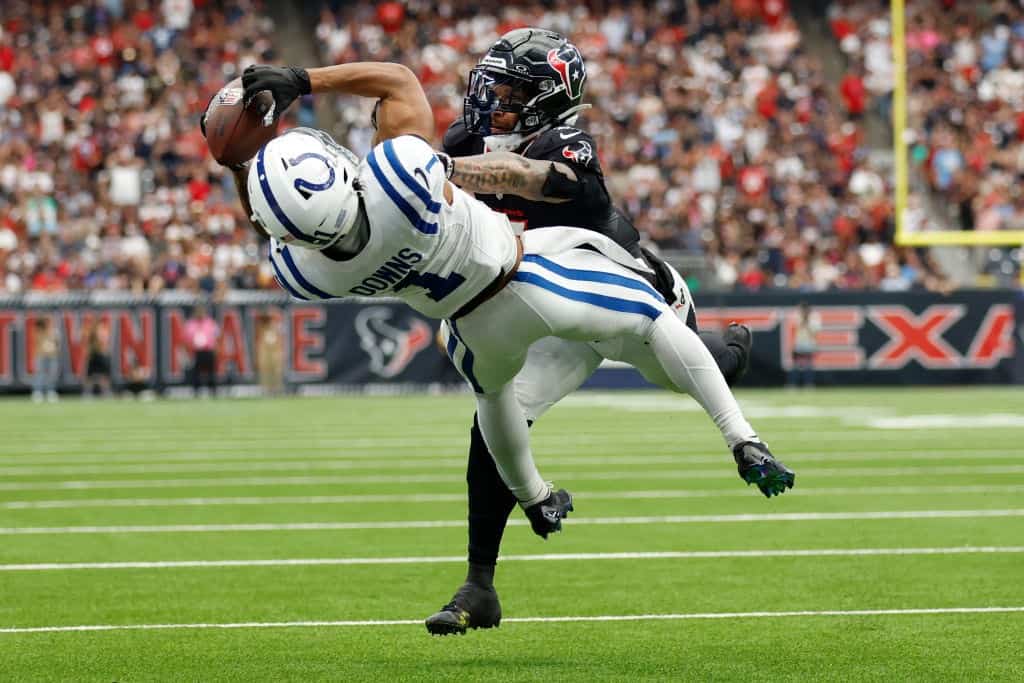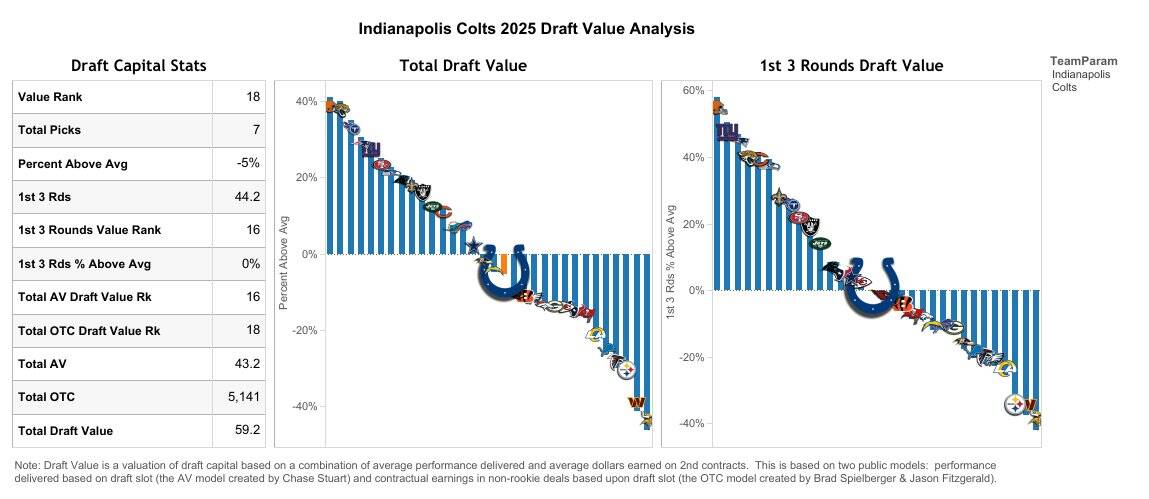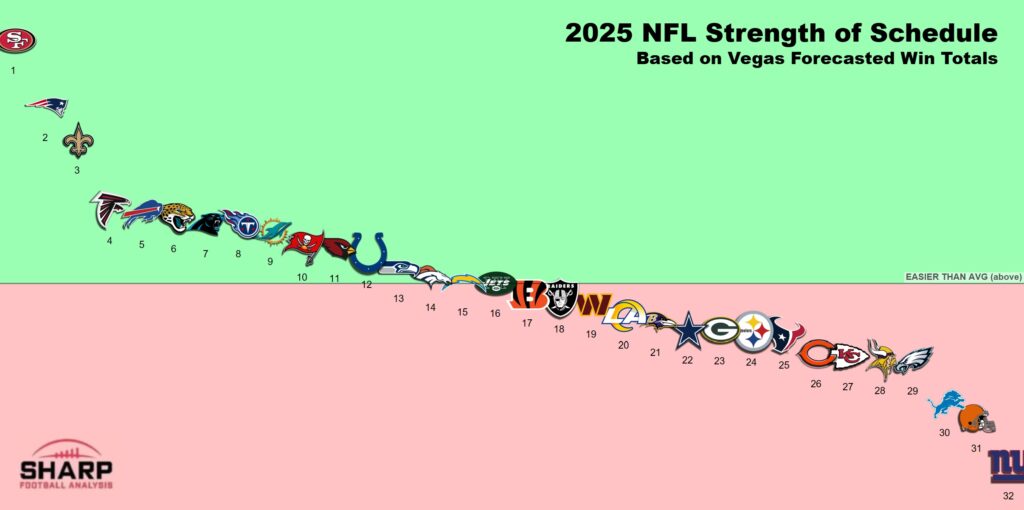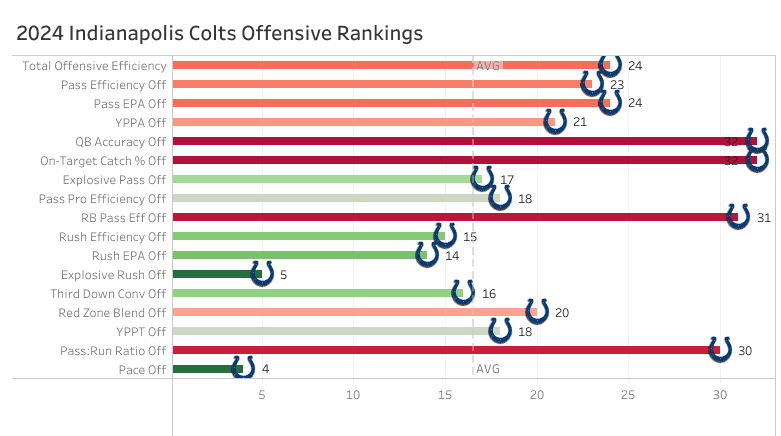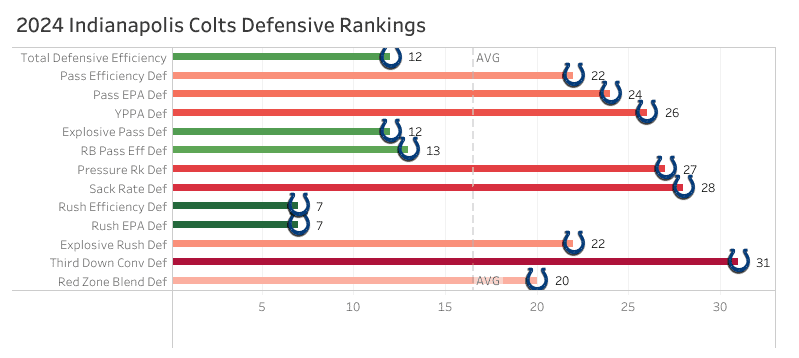As a lead-up to the 2025 NFL draft, we've broken down the current depth chart of every NFL team and identified the biggest draft and team needs for the Indianapolis Colts.
You can find additional team-by-team draft needs articles and other draft content on our 2025 NFL Draft Hub.
Indianapolis Colts Needs: Top Positions of Need in 2025
- Offensive Line
- Tight End
- Edge Rusher
What Picks Do the Indianapolis Colts Have in 2025?
The Indianapolis Colts have 7 picks in the 2025 NFL Draft, including:
- Round 1 (14)
- Round 2 (45)
- Round 3 (80)
- Round 4 (117)
- Round 5 (151)
- Round 6 (189)
- Round 7 (232)
Preorder The Best Analytical 2025 Football Preview
Don't miss out on Warren Sharp's 500+ page preview of the 2025 NFL season.
The preview is unlike anything you have ever seen, featuring stunning visualizations built with the reader in mind.
This preview shares insights into players, coaches, teams, and philosophies with one goal in mind: to get you prepared for the 2025 NFL season by delivering the smartest information in the fastest, most direct way possible.
Preorder the 2025 Football Preview now!
Indianapolis Colts 2025 Draft Capital Stats
The Colts have the 18th-most draft capital according to our Sharp Football Draft Value.
Our Sharp Football Draft Value is a valuation of draft capital based on a combination of average performance delivered and average dollars earned on second contracts.
Indianapolis Colts Draft Value vs. Other Teams:
The Colts’ draft value is 5% lower than the league average of all 32 teams.
Indianapolis Colts Draft Prediction:
Find out who our top-rated experts expect the Colts to draft:
- Brendan Donahue's 2025 NFL Mock Draft – Complete first round breakdown from the #2 most accurate mock drafter over the last five seasons.
- Ryan McCrystal's 2025 NFL Mock Draft – Complete first round breakdown from the #8 most accurate mock drafter over the last five seasons.
Indianapolis Colts Strength of Schedule, 2025
The Indianapolis Colts have the 12th-easiest NFL strength of schedule for the 2025 NFL season.
Indianapolis Colts Offense: Depth Chart, Analysis & Draft Needs
Rich Hribar breaks down the offensive depth chart by position for the Indianapolis Colts, identifying areas where the team could improve in the upcoming 2025 NFL Draft.
Quarterback Depth Chart, Colts:
- Anthony Richardson
- Daniel Jones
- Jason Bean
The Colts are heading into the 2025 season with more questions than answers at the quarterback position after Anthony Richardson struggled in his second season.
Among the 36 quarterbacks to qualify for the league’s passer rating, Richardson completed a league-low 47.7% of his passes.
The next closest player completed 60.6%.
Entering the league with significant red flags in terms of accuracy, Richardson checked every negative box in completing 10.9% fewer passes than expected (the worst in the league).
A league-high 17.8% of his passes were inaccurate throws.
The average among the players who qualified for passer rating was a 10.6% inaccurate throw rate.
Richardson took a high rate of throws that came with a decreased success rate.
He averaged a league-high 12.2 air yards per pass attempt.
That was the highest rate since Tim Tebow in 2011 (12.9 yards downfield).
A league-high 22.7% of his passes were 20 or more yards downfield.
Tebow’s 2011 season was the only season with a higher rate (24%) since the data has been tracked.
Richardson completed only 34.4% of his passes (44 of 128) 10 or more yards downfield, the lowest rate in the league.
The only other seasons with a lower rate since 2010 were DeShone Kizer in 2017 at 32.7% (55 of 168) and Tebow in 2011 at 33.1% (48 of 145).
That’s a lot of Tebow popping up as the closest comparable seasons.
Richardson had a 6.1% drop rate from his pass catchers, the third-highest rate in the league.
He only had a clean pocket on 53.5% of his dropbacks, which was 33rd in the league.
It is easy to make some excuses here based on Richardson's taking a high rate of inefficient throws, suffering a high rate of drops, and poor offensive line play.
However, the bottom line is that Richardson still struggled to cash in on the free squares required to keep an NFL offense on schedule.
Richardson completed 60.3% of his passes on throws under 10 yards downfield, the lowest rate in a season since C.J. Beathard in 2017 (58.3%).
Richardson had a 16.8% inaccurate throw rate from a clean pocket.
The average was 9.3%.
This is why we saw Richardson benched for a stint last season.
20.5% of Richardson’s dropbacks resulted in a play that lost 1.0 EPA or worse, 35th in the league.
We do not have many examples of quarterbacks with these types of early-career accuracy issues who have put things together and fixed those problems.
That said, the Colts did go 6-5 in Richardson’s 11 starts and 2-4 in the other games.
They averaged 5.5 yards per play when Richardson was in the game (14th) compared to 5.1 yards without him (25th).
However, that was due to the boom-or-bust nature of this offense operated under Richardson.
The Colts had a 39.4% success rate with Richardson off the field (23rd) compared to a 37.2% rate on the field (31st).
The volatile nature of Richardson’s game led to the team benching him for two weeks last season.
The team has added Daniel Jones on a one-year contract to create competition this offseason.
The only player Jones finished ahead of last season in rating (79.4) was Richardson (61.6).
The odd part about Jones's addition is that these quarterbacks play a different style despite subpar efficiency, which complicates the consistency of this offense.
While Richardson is a high-variance player who wants to push the ball downfield and take shots with his arm strength, Jones is a low-ceiling player who has needed hand-holding in coaxing out the best spurts of his career in New York.
We highlighted that Richardson took the most shots downfield of any quarterback.
Since Jones entered the league in 2019, he has averaged 7.3 air yards per pass attempt, 38th among 45 qualifying quarterbacks.
Just 8.7% of his career throws have gone 20 or more yards downfield (43rd).
To compound matters, Jones has struggled in the short passing game.
On that same list of 45 quarterbacks, he ranks 40th in rating on throws under 10 yards downfield.
You can make excuses for Jones based on the quality of pass catchers he had in New York, but he was 31st in that department last season with the addition of Malik Nabers.
This staff was undoubtedly frustrated by Richardson’s inconsistency, but is Jones going to change that while providing a lower ceiling for this offense?
There is a good shot that both quarterbacks will start games in 2025.
Richardson has missed 17 games so far with injuries, and the Colts have said this will be a competition.
If both quarterbacks start, the Colts will not have a long-term solution at the position and should be forced to reset things in 2026.
Running Back Depth Chart, Colts:
- Jonathan Taylor
- Khalil Herbert
- Salvon Ahmed
- Tyler Goodson
Jonathan Taylor again had a high workload as a running back in 2024, turning 321 touches into 1,567 total yards and 12 touchdowns.
Taylor accounted for 89.4% of the backfield touches in the games he played.
His 21.6 rushing attempts per game were tied for the most in the league with Saquon Barkley.
Taylor averaged a career low 2.68 yards after contact per rush, and 10.2% of his runs went for 10 or more yards, the lowest rate of his career.
That said, he did close the season on a high note, going over 100 yards rushing in the final four games with 6 touchdowns over that span.
Taylor had games with 218 yards and 177 yards rushing over that period.
When he is at his best, his ceiling is still high.
Taylor is signed for two more seasons, but he also missed multiple games for the third season in a row.
With Taylor absent, the lack of depth was again an issue.
With Taylor off the field, reserve running backs averaged 3.5 YPC and a 34.1% success rate.
Only 8.0% of their runs went for 10 or more yards.
The team added Khalil Herbert on a one-year contract, but this draft is ripe for the Colts to add competition behind Taylor.
Taylor is the only running back under contract beyond this season.
Wide Receiver Depth Chart, Colts:
- Michael Pittman
- Alec Pierce
- Josh Downs
- Adonai Mitchell
- Ashton Dulin
- Anthony Gould
- Laquon Treadwell
- DJ Montgomery
- Ajou Ajou
The Colts have talent and contractual depth at wide receiver. The unit just needs better quarterback play to maximize its potential.
Michael Pittman, Josh Downs, and Adonai Mitchell are all signed for multiple seasons.
Pittman had a disappointing season last year, dealing with added target competition, subpar quarterback play, and playing through an ongoing back injury.
Pittman ended last year averaging 4.3 catches for 50.5 yards per game, his lowest rates since his rookie season.
His quality of target declined.
14.4% of his targets were inaccurate, his highest rate since his rookie season.
His 11.1 air yards per target were the highest of his career.
Pittman's contract still has cap hits of $23 million (all guaranteed) in 2025 and $29 million (only $5 million would be dead cap) in 2026.
Josh Downs has flashed as a high-efficiency receiver through two seasons but has been limited due to injuries and his role as a slot receiver in a low-volume passing offense.
Downs improved across the board in his second season, catching 72 of 107 targets for 803 yards and 5 touchdowns.
Downs was targeted on 29.4% of his routes, trailing only Puka Nacua (38.3%) and Malik Nabers (30.9%) last season.
His 2.21 yards per route ranked 19th at the position.
The rub is that he was only on the field for 75.5% of the dropbacks in his games since 77.4% of his snaps were from the slot.
The Colts only averaged 27.0 dropbacks per game with Anthony Richardson in the game, which was last in the NFL.
Alec Pierce only had 37 catches last season, but he made the most of them.
He led the NFL with 22.3 yards per catch while leading the team with 7 touchdowns.
Pierce was a boom-or-bust receiver reliant on downfield targets.
He had three 100-yard games and was below 50 yards in 9 games.
He was targeted on only 15.3% of his routes, ranking him 92nd among wide receivers who ran 100 or more routes.
But he averaged 21.7 air yards per target, the league's highest.
47.8% of his targets were 20 or more yards downfield, the highest rate.
Pierce is in the final season of his rookie contract.
The team has his potential replacement in place in Adonai Mitchell.
Mitchell was selected in the second round last season, catching 23 of 55 targets for 312 yards and 0 touchdowns.
While those rookie numbers are hardly flattering, Mitchell was road-blocked as the WR4 in this offense while being the wide receiver most impacted by Anthony Richardson‘s issues as a passer.
Mitchell was only on the field for 36.3% of the team dropbacks but was targeted on 26.7% of his routes (second on the team).
Mitchell ranked eighth in ESPN’s Open Score for wide receivers on his limited sample.
But 25.5% of his targets were inaccurate.
Rome Odunze (26.7%) was the only wide receiver with a higher rate and as many targets as Mitchell.
31% of his targets from Richardson were inaccurate.
The Colts have added contractual depth here with Ashton Dulin and Anthony Gould, each under contract for multiple seasons.
Tight End Depth Chart, Colts:
- Andrew Ogletree
- Mo Alie-Cox
- Jelani Woods
- Will Mallory
- Sean McKeon
- Albert Okwuegbunam
The Colts got next to nothing from this unit in 2024.
They targeted their tight ends only 15.2% of the time last season, 29th in the league.
On those targets, Indianapolis tight ends combined for a league-low 39 receptions, 467 yards (31st), and 2 touchdowns (29th).
The tight end who led the position in targets last season (Kylen Granson) is no longer on the roster, and Mo Alie-Cox was only re-signed in April on a one-year deal.
Bringing back Alie-Cox at least gives them some stability here, but it does not solve the long-term concern.
The only tight end here who is under contract beyond this upcoming season is Will Mallory.
There is a reason that the Colts are frequently linked to Tyler Warren in mock drafts.
Even if Warren is off the board by the time the Colts pick at 14 overall, expect a player to be added here during the draft.
Offensive Line Depth Chart, Colts:
LT: Bernhard Raimann, Blake Freeland
LG: Quenton Nelson, Josh Sills, Antonio Mafi
C: Tanor Bortolini, Danny Pinter, Wesley French
RG: Matt Goncalves, Dalton Tucker
RT: Braden Smith, Luke Tenuta, Jack Wilson
This offensive line had a plethora of issues staying healthy last season.
The Colts had six different combinations on the line play 100-plus snaps (the most in the league), but none played more than 200 snaps.
Their most frequent combination on the line was on the field for only 17.9% of their offensive snaps, the lowest rate in the league.
Quenton Nelson was their lineman to play in all 17 games. Every other starter missed multiple games.
Nelson still has two years remaining on his current contract and is still an effective player.
According to Pro Football Focus, he ranked eighth in overall grade among guards last season, allowing a 3.3% pressure rate (19th).
Nelson remains the anchor up front, but the rest of the line has more moving parts.
Braden Smith is still a reliable starter when he is available, but he has missed 12 games over the past two seasons.
He is in the final season of his current contract.
Bernhard Raimann has made 40 starts for the Colts over his first three years in the league, but his contract expires at the end of this season.
Offensive tackle is open for a rookie to come in and compete with Raimann and provide insurance beyond this season.
The Colts made some preparations that could lose one or both of their starting tackles after the 2025 season by selecting Matt Goncalves in the third round last season.
Goncalves was pushed into eight starts as a rookie, playing 333 snaps at right tackle and 230 at left tackle.
On those snaps, he played like a rookie tackle pushed into action.
He allowed a 7.2% pressure rate (77th among tackles).
Goncalves could compete to be a guard in his second season after Will Fries left the team in free agency.
Fries, Mark Glowinski, and Dalton Tucker all took snaps at right guard last season.
Fries and Glowinski are no longer on the roster.
Tucker led the team with 464 snaps at right guard but was 70th among guards in overall grade per Pro Football Focus.
Tucker allowed an 8.6% pressure rate last season, which ranked 89th out of 96 guards to play 100-plus snaps.
The team selected Tanor Bortolini in the fourth round last season as a potential replacement for Ryan Kelly, who left the team in free agency this spring.
Bortolini made five starts as a rookie, playing 348 of his 351 snaps at center.
Shane Steichen has said that Bortolini will compete with Danny Pinter for the starting role.
Pinter is only under contract for this season.
We should expect the Colts to add multiple players again on the line this spring.
Indianapolis Colts Defense: Depth Chart, Analysis & Draft Needs
Raymond Summerlin breaks down the defensive depth chart by position for the Indianapolis Colts, identifying areas where the team could improve in the upcoming 2025 NFL Draft.
Defensive Line Depth Chart, Colts:
- DeForest Buckner
- Grover Stewart
- Neville Gallimore
- Adetomiwa Adebawore
- Pheldarius Payne
The Colts gave up a lot of rushing yards last year (1,821 to running backs, 26th), but their per carry numbers were much better.
Indy ranked 11th in yards per carry allowed to RBs (4.2) and fifth in yards before contact allowed on those runs (0.98).
While the two guys atop the depth chart are a little older, they make up one of the better duos in the league.
DeForest Buckner logged 6.5 sacks in 2024, ranking 56th among all qualified pass rushers – not just interior linemen – in pressure rate at 11.1%.
He has consistently been right around those totals since joining the Colts in 2020.
Grover Stewart finished first among all qualified defensive linemen in run stuffs with 23, logging a tackle on 18.7% of his run defense snaps (7th).
Buckner recorded a tackle on 19.7% of his run defense snaps, which ranked sixth among that same group.
Indy added Neville Gallimore in free agency, but there are still depth questions behind that outstanding top two.
As mentioned above, Buckner and Stewart are also getting older, and each will be a free agent after the 2026 season.
Adding some young depth here could make some sense, but overall, the Colts are in a good spot at defensive tackle.
EDGE Depth Chart, Colts:
- Kwity Paye
- Laiatu Latu
- Samson Ebukam
- Tyquan Lewis
- Durell Nchami
- Isaiah Land
The Colts massively overshot their expected sack total in 2023, finishing with 51 (5th) despite posting a 32.4% pressure rate (26th).
The pressure rate got worse in 2024 (29.1%), and the sacks predictably fell off a cliff.
The Colts finished 25th with 36 sacks last year.
To add some more concern, Indy saw Dayo Odeyingbo leave in free agency, though he had just 3 sacks with a 10% pressure rate last year.
Indy did at least try to solidify this unit in the draft last season, taking Laiatu Latu in the first round.
He finished third on the team with 4 sacks, logging a 10.6% pressure rate in 357 pass rush snaps.
That pressure rate ranked 63rd among qualified pass rushers, so there is room for improvement in year two.
Kwity Paye led the team with 8 sacks, his second season in a row getting to 8 takedowns despite a lackluster pressure rate.
He did better that pressure number to 10.1% in 2024.
A 2021 first-round pick, Paye will play this season on his fifth-year option and is scheduled to hit free agency in 2026.
Samson Ebukam missed all of 2024 because of a training camp Achilles injury.
He had 9.5 sacks in 2023, and the timing of the injury means he should be a full go for training camp.
Ebukam is also going to be 30 before the start of the season and is coming off a serious injury.
Like Paye, he is also scheudled ot be a free agent after this season.
Tyquan Lewis is also still around to contribute snaps, and the Colts would be fine going into the season with that top four.
That said, they both need more impact at the top of the depth chart and a plan for the future.
Perhaps Latu can answer both of those questions with a breakout season – or new DC Lou Anarumo can be more creative than the previous staff – but adding some help makes sense.
Linebacker Depth Chart, Colts:
- Zaire Franklin
- Jaylon Carlies
- Cameron McGrone
- Segun Olubi
- Austin Ajiake
- Liam Anderson
- Jacob Phillips
Zaire Franklin is locked in atop this depth chart.
He finished second among qualified linebackers in run stuffs last season and recorded a tackle on 19.1% of his run defense snaps.
Franklin has not been as great in coverage, but he is a quality option atop the depth chart.
The spot next to him remains in question.
E.J. Speed played that role last season, but he left in free agency.
2024 fifth-round pick Jaylon Carlies got some run last season and is likely the favorite to start right now, but he is unproven.
The Colts also brought back both Cameron McGrone and Segun Olubi as depth.
Even so, it would not be surprising if Indy tries to land a starter at linebacker in the draft.
Cornerback Depth Chart, Colts:
- Charvarius Ward
- Kenny Moore II
- Jaylon Jones
- JuJu Brents
- Samuel Womack
- Corey Ballentine
- David Long Jr.
- Alex Johnson
The Colts allowed 7.6 yards per attempt last season (27th) and a 5% touchdown rate (20th).
They did turn the ball over, though, recording 16 interceptions (5th).
The biggest among Indy’s many big free agent additions, Charvarius Ward joined the Colts on a three-year contract.
Ward gives new DC Lou Anarumo a true No. 1 option on the outside to par with slot corner Kenny Moore, who should also fit in well with the new defensive coordinator.
Ward had a tough season off the field in 2024, but he was 31st among all qualified corners in yards allowed per coverage snap back in 2023.
As for Moore, he allowed just 5.5 yards per target and an 83.6 quarterback rating in his coverage last season.
The next spot on the depth chart is less settled.
2023 seventh-round pick Jaylon Jones was the primary option last season, but he had a bit of a tough go, allowing 1.2 yards per coverage snap.
He ranked 12th among all eligible corners in that metric in 2023, though, and has a lot of starting experience through two seasons.
Jones should be the favorite, but the Colts do still have 2023 second-round pick JuJu Brents and Samuel Womack to compete for that No. 3 job.
Given the competition available, Indy is probably set here after adding Ward.
Safety Depth Chart, Colts:
- Cam Bynum
- Nick Cross
- Rodney Thomas
- Daniel Scott
- Marcel Dabo
In addition to Ward at corner, the Colts made another big splash in the secondary, signing Cam Bynum to a four-year, $60 million deal.
Bynum should take over the starting spot vacated by Julian Blackmon, who remains a free agent.
2022 third-round pick Nick Cross will retain the other starting spot and is a good partner for Bynum, who should play more of the free safety role.
Cross was 10th among all qualified safeties last season with a tackle on 15.9% of his run defense snaps.
Cross is heading into the final year of his rookie deal, adding some contractual questions to this unit, and there is no established depth behind that top pair.
That could prompt the Colts to look toward safety at some point in the draft.


